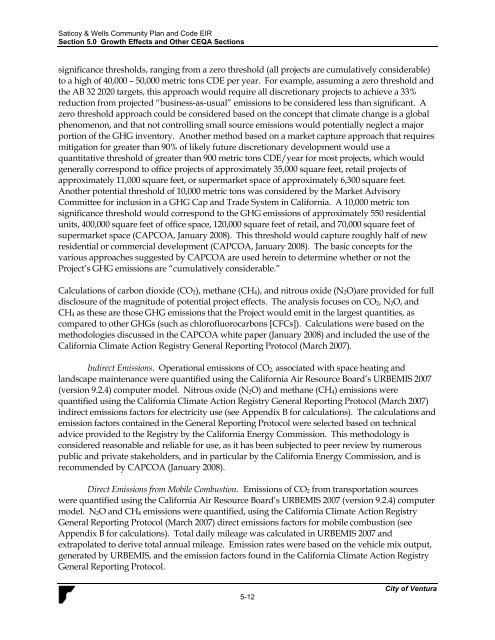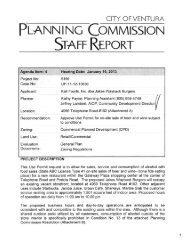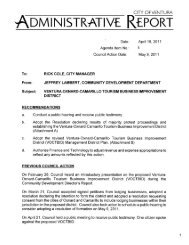Saticoy & Wells Community Plan & Development ... - City Of Ventura
Saticoy & Wells Community Plan & Development ... - City Of Ventura
Saticoy & Wells Community Plan & Development ... - City Of Ventura
Create successful ePaper yourself
Turn your PDF publications into a flip-book with our unique Google optimized e-Paper software.
<strong>Saticoy</strong> & <strong>Wells</strong> <strong>Community</strong> <strong>Plan</strong> and Code EIRSection 5.0 Growth Effects and Other CEQA Sectionssignificance thresholds, ranging from a zero threshold (all projects are cumulatively considerable)to a high of 40,000 – 50,000 metric tons CDE per year. For example, assuming a zero threshold andthe AB 32 2020 targets, this approach would require all discretionary projects to achieve a 33%reduction from projected “business-as-usual” emissions to be considered less than significant. Azero threshold approach could be considered based on the concept that climate change is a globalphenomenon, and that not controlling small source emissions would potentially neglect a majorportion of the GHG inventory. Another method based on a market capture approach that requiresmitigation for greater than 90% of likely future discretionary development would use aquantitative threshold of greater than 900 metric tons CDE/year for most projects, which wouldgenerally correspond to office projects of approximately 35,000 square feet, retail projects ofapproximately 11,000 square feet, or supermarket space of approximately 6,300 square feet.Another potential threshold of 10,000 metric tons was considered by the Market AdvisoryCommittee for inclusion in a GHG Cap and Trade System in California. A 10,000 metric tonsignificance threshold would correspond to the GHG emissions of approximately 550 residentialunits, 400,000 square feet of office space, 120,000 square feet of retail, and 70,000 square feet ofsupermarket space (CAPCOA, January 2008). This threshold would capture roughly half of newresidential or commercial development (CAPCOA, January 2008). The basic concepts for thevarious approaches suggested by CAPCOA are used herein to determine whether or not theProject’s GHG emissions are “cumulatively considerable.”Calculations of carbon dioxide (CO 2 ), methane (CH 4 ), and nitrous oxide (N 2 O)are provided for fulldisclosure of the magnitude of potential project effects. The analysis focuses on CO 2 , N 2 O, andCH 4 as these are those GHG emissions that the Project would emit in the largest quantities, ascompared to other GHGs (such as chlorofluorocarbons [CFCs]). Calculations were based on themethodologies discussed in the CAPCOA white paper (January 2008) and included the use of theCalifornia Climate Action Registry General Reporting Protocol (March 2007).Indirect Emissions. Operational emissions of CO 2, associated with space heating andlandscape maintenance were quantified using the California Air Resource Board’s URBEMIS 2007(version 9.2.4) computer model. Nitrous oxide (N 2 O) and methane (CH 4 ) emissions werequantified using the California Climate Action Registry General Reporting Protocol (March 2007)indirect emissions factors for electricity use (see Appendix B for calculations). The calculations andemission factors contained in the General Reporting Protocol were selected based on technicaladvice provided to the Registry by the California Energy Commission. This methodology isconsidered reasonable and reliable for use, as it has been subjected to peer review by numerouspublic and private stakeholders, and in particular by the California Energy Commission, and isrecommended by CAPCOA (January 2008).Direct Emissions from Mobile Combustion. Emissions of CO 2 from transportation sourceswere quantified using the California Air Resource Board’s URBEMIS 2007 (version 9.2.4) computermodel. N 2 O and CH 4 emissions were quantified, using the California Climate Action RegistryGeneral Reporting Protocol (March 2007) direct emissions factors for mobile combustion (seeAppendix B for calculations). Total daily mileage was calculated in URBEMIS 2007 andextrapolated to derive total annual mileage. Emission rates were based on the vehicle mix output,generated by URBEMIS, and the emission factors found in the California Climate Action RegistryGeneral Reporting Protocol.5-12<strong>City</strong> of <strong>Ventura</strong>
















